LOS ANGELES — Even with a sixth atmospheric river in two weeks dumping rain on California, water regulators said reservoirs are not likely to completely refill this year. As of Monday night, the state’s 154 reservoirs were at 81% of average, the Department of Water Resources announced Tuesday.
“We’re still below average,” said Jon Yarbrough, assistant deputy director for the State Water Project, the California agency that collects water from Northern California rivers and redistributes it to major cities. “We still have a lot of room in our reservoirs to take in the in-flows that we’re seeing on the horizon here.”
One of the largest reservoirs, Lake Oroville in Northern California, has increased by more than 85 feet since Dec. 1. Still, it remains at 46% capacity, currently holding just 1.6 million acre-feet of its 3.5 million potential. Over the next nine days, Yarbrough expects the rains will deliver another 500,000 acre-feet to Oroville, but it will remain significantly below normal.
The San Luis Reservoir, south of San Francisco, has risen 33 feet and added 287,000 acre-feet since Dec. 1 but remains at 39% of capacity. The Shasta reservoir, operated by the U.S. Bureau of Land Management and with 8.8 million acre-feet of capacity, has gained 400,000 acre-feet since early December and is currently 41% full.
Three more storms are expected in California over the next nine days, according to Department of Water Resources state climatologist Dr. Michael Anderson. Even so, the likelihood of reservoirs getting back to full capacity this year “would be a bit of a challenge,” Anderson added.
“To get them to the top of conservation would take more storms, but what can help as we move later in the spring is snowmelt,” he said. “It takes a while to get the system storage built back up. We have some pretty large deficits to overcome.”
According to the most recent map from the U.S. Drought Monitor, released Jan. 5, the entire state of California continues to experience drought conditions, despite the rain.



